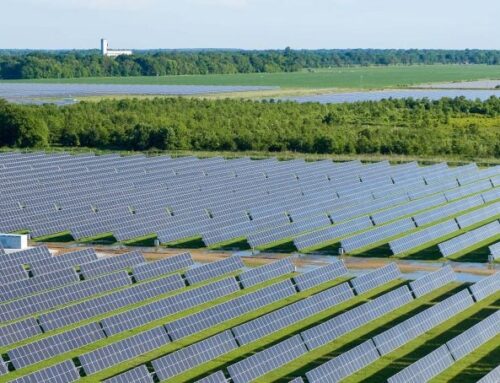Wisconsin lawmakers look to break utility grip on community solar
November 19, 2025

On a dry, rocky patch of his family’s farm in Door County, Wisconsin, Dave Klevesahl grows wildflowers. But he has a vision for how to squeeze more value out of the plot: lease it to a company that wants to build a community solar array.
Unfortunately for Klevesahl, that is unlikely to happen under current state law. In Wisconsin, only utilities are allowed to develop such shared solar installations, which let households and businesses that can’t put panels on their own property access renewable energy via subscriptions.
Farmers, solar advocates, and legislators from both parties are trying to remove these restrictions through Senate Bill 559, which would allow the limited development of community solar by entities other than utilities.
Wisconsin lawmakers considered similar proposals in the 2021–2022 and 2023–2024 legislative sessions, with support from trade groups representing real estate agents, farmers, grocers, and retailers. But those bipartisan efforts failed in the face of opposition from the state’s powerful utilities and labor unions.
Community solar supporters are hoping for a different outcome this legislative session, which ends in March. But while the new bill, introduced Oct. 24, includes changes meant to placate utilities, the companies still firmly oppose it.
“I don’t really understand why anybody wouldn’t want community solar,” said Klevesahl, whose wife’s family has been farming their land for generations. In addition to leasing his land for an installation, he would like to subscribe to community solar, which typically saves participants money on their energy bills.
Some Wisconsin utilities do offer their own community solar programs. But they are too small to meet the demand for community solar, advocates say.
Utilities push back on shared solar
Around 20 states and Washington, D.C., have community solar programs that allow non-utility ownership of arrays. The majority of those states, including Wisconsin’s neighbor Illinois, have deregulated energy markets, in which the utilities that distribute electricity do not generate it.
In states with “vertically integrated” energy markets, like Wisconsin, utilities serve as regulated monopolies, both generating and distributing power. That means legislation is necessary to specify that other companies are also allowed to generate and sell power from community solar. Some vertically integrated states, including Minnesota, have passed such laws.
But monopoly utilities in those jurisdictions have consistently opposed community solar developed by third parties. Minnesota utility Xcel Energy, for example, supported terminating the state’s community solar program during an unsuccessful effort by some lawmakers last summer to end it.
The Wisconsin utilities We Energies and Madison Gas and Electric, according to their spokespeople, are concerned that customers who don’t subscribe to community solar will end up subsidizing costs for those who do. The utilities argue that because community solar subscribers have lower energy bills, they contribute less money for grid maintenance and construction, meaning that other customers must pay more to make up the difference. Clean-energy advocates, for their part, say this “cost shift” argument ignores research showing that the systemwide benefits of distributed energy like community solar can outweigh the expense.
The Wisconsin bill would also require utilities to buy power from community solar arrays that don’t have enough subscribers.
“This bill is being marketed as a ‘fair’ solution to advance renewables. It’s the opposite,” said We Energies spokesperson Brendan Conway. “It would force our customers to pay higher electricity costs by having them subsidize developers who want profit from a no-risk solar project. Under this bill, the developers avoid any risk. The costs of their projects will shift to and be paid for by all of our ‘non-subscribing’ customers.”
The power generated by community solar ultimately goes onto the utility’s grid, reducing the amount of electricity the utility needs to provide. But Conway said it’s not the most efficient way to meet overall demand.
“These projects would not be something we would plan for or need, so our customers would be paying for unneeded energy that benefits a very few,” he said. “Also, these credits are guaranteed by our other customers even if solar costs drop or grid needs change.”
Advocates in Wisconsin hope they can address such concerns and convince utilities to support community solar owned by third parties.
Beata Wierzba, government affairs director of the clean-power advocacy organization Renew Wisconsin, said her group and others “had an opportunity to talk with the utilities over the course of several months, trying to negotiate some language they could live with.”
“There were some exchanges where utilities gave us a dozen things that were problematic for them, and the coalition addressed them by making changes to the draft” of the bill, Wierzba said.
The spokespeople for We Energies and Madison Gas and Electric did not respond to questions about such conversations.
A small-scale start
To assuage utilities’ concerns, the bill allows third-party companies to build community solar only for the next decade. The legislation also sets a statewide cap for community solar of 1.75 gigawatts, with limits for each of the five major investor-owned utilities’ territories proportionate to each utility’s total number of customers.
Community solar arrays would be limited to 5 megawatts, with exceptions for rooftops, brownfields, and other industrial sites, where 20 megawatts can be built.
No subscriber would be allowed to buy more than 40% of the output from a single community solar array, and 60% of the subscriptions must be for 40 kilowatts of capacity or less, the bill says. This is meant to prevent one large customer — like a big-box store or factory — from buying the majority of the power and excluding others from taking advantage of the limited community solar capacity.
Customers who subscribe to community solar would still have to pay at least $20 a month to their utility for service. The bill also contains what Wierzba called an “off-ramp”: After four years, the Public Service Commission of Wisconsin would study how the program is working and submit a report to the legislature, which could pass a new law to address any problems.
“The bill is almost like a small pilot project — it’s not like you’re opening the door and letting everyone come in,” said Wierzba. “You have a limit on how it can function, how many people can sign up.”
Broad support for community solar
In Wisconsin, as in other states, developers hoping to build utility-scale solar farms on agricultural land face serious pushback. The Trump administration canceled federal incentives for solar arrays on farms this summer, with U.S. Department of Agriculture Secretary Brooke Rollins announcing, “USDA will no longer fund taxpayer dollars for solar panels on productive farmland.”
But Wisconsin farmers have argued that community solar can actually help keep agricultural land in production by providing an extra source of revenue. The Wisconsin Farm Bureau Federation has yet to weigh in on this year’s bill, but it supported previously proposed community solar legislation.
The bill calls for state regulators to come up with rules for community solar developers that would likely require dual use — meaning that crops or pollinator habitats are planted under and around the panels or that animals graze on the land. These increasingly common practices are known as agrivoltaics.
The bill would let local zoning bodies — rather than the state’s Public Service Commission — decide whether to permit a community solar installation.
Utility-scale solar farms, by contrast, are permitted at the state level, which can leave “locals feeling like they are not in control of their future,” said Matt Hargarten, vice president of government and public affairs for the Coalition for Community Solar Access. “This offers an alternative that is really welcome. If a town doesn’t want this to be there, it won’t be there.”
A 5-megawatt array typically covers 20 to 30 acres of land, whereas utility-scale solar farms are often hundreds of megawatts and span thousands of acres.
“You don’t need to upgrade the transmission systems with these small solar farms, because a 30-acre solar farm can backfeed into a substation that’s already there,” noted Klevesahl, a retired electrical engineer. “And then you’re using the power locally, and it’s clean power. Bottom line is, I just think it’s the right thing to do.”
{
if ($event.target.classList.contains(‘hs-richtext’)) {
if ($event.target.textContent === ‘+ more options’) {
$event.target.remove();
open = true;
}
}
}”
>
Kari Lydersen
is a contributing reporter at Canary Media who covers Illinois, Indiana, and Wisconsin.
read next
Search
RECENT PRESS RELEASES
Related Post


